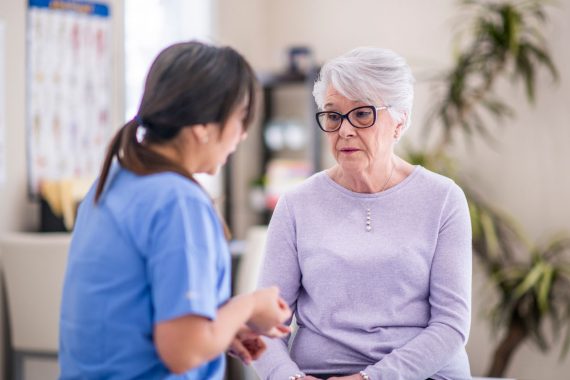New draft guidelines from NICE to reduce the number of falls in those at risk could be challenging to implement because of a lack of resources, GPs have warned.
The updated guidance now out for consultation recommends that home hazard assessments should be carried out by an occupational therapist as evidence has shown these are more effective.
It also advises a comprehensive falls assessment and management for people who have fallen in the past year and are living with frailty, were injured in a fall, experienced loss of consciousness, have been unable to get up independently after a fall, or have had two or more falls.
Structured medication reviews should be used to identify any medicines that increase the risks of falls and how they may be adjusted.
And interventions that can also be considered include a falls prevention exercise programme, NICE said.
These should be individualised based on an assessment and tailored according to the level of risk of falling, according to the guidelines which covers people aged over 65 or those aged 50 to 64 years with a condition that increases their risk of falling.
A person’s progression and continuing benefit from the exercise programmes should be reviewed regularly, the committee said.
The recommendations also noted that falls risk prediction tools should not be used to predict a person’s risk of falling.
NICE said it was particularly seeking clinician feedback on the proposed recommendation that home hazard assessments should be carried out by an occupational therapist because of staff shortages in some areas.
In 2022/23 there were around 210,000 emergency hospital admissions in England related to falls for people aged 65 and over.
Fragility fractures cost the UK an estimated at £4.4bn which includes £1.1bn for social care. Hip fractures alone account for around £2bn of this sum.
Professor Jonathan Benger, chief medical officer and deputy chief executive at NICE, said: ‘Falls present a major, growing public health problem which can have devastating consequences for older people, their families, and the healthcare service.
‘This useful and useable guideline has been updated to help identify those people at greatest risk and provide them with the help and support they need to maintain their independence and live full, active lives.’
Professor Azeem Majeed, a GP and professor of primary care and public health at Imperial College London, said the evidence-based guidelines could reduce falls among older adults, ‘but their feasibility and impact depends on addressing some key challenges’.
‘The recommendation for occupational therapists to conduct home hazard assessments could reduce the frequency of falls in higher-risk people and improve health outcomes but may face implementation barriers due to workforce shortages.
‘Similarly, expanding falls prevention exercise programmes and comprehensive falls assessments will require funding, logistical support, and collaboration across healthcare teams.’
While promising local healthcare systems may need ‘flexible, phased approaches to overcome resource limitations’, he added.
Professor Majeed also noted that many patients don’t report falls if they don’t result in a significant injury and so not all at-risk people will be identified for inclusion in prevention programmes.
NICE draft recommendations on falls: assessment and prevention in older people and in people 50 and over at higher risk
- Do not use falls risk prediction tools to predict a person’s risk of falling
- Offer comprehensive falls assessment and management for people who have fallen in the past year and:
- are living with frailty or
- were injured in a fall or
- have experienced loss of consciousness related to a fall or
- have been unable to get up independently after a fall or
- have had 2 or more falls
- For people who have fallen in the past year who have a gait or balance impairment, offer a falls prevention exercise programme and consider a home hazard assessment
1.3.5 Offer a home hazard assessment and intervention, carried out by an occupational therapist, using a validated tool.
1.3.8 Consider a falls prevention exercise programme for people who need comprehensive assessment and management.
1.3.9 Falls prevention exercise programmes should:
- be delivered by appropriately trained professionals
- be tailored to the person’s specific needs, preferences, goals and abilities
- focus on functional components related to the person’s risk of falls, such as balance, coordination, strength and power
- include regular exercise progress reviews
- be delivered in such a way, including duration of programme, to bring about physical activity behaviour change related to physical activity and sedentary habits
1.3.10 Consider cognitive behavioural approaches for people who have a fear of falling who do not respond to strength and balance exercises.
Source: NICE














So a resourced falls service headed by a geriatrician with OTs and physiotherapists, with a self referral pathway because – crazy idea – GP to kindly confirm the patient has fallen – is a complete waste of my time.